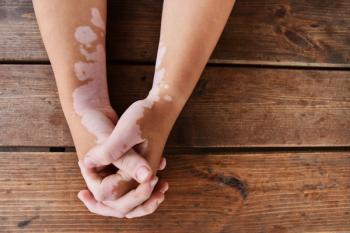
Jacquet's Dermatitis: An Unusual Type of Diaper Rash
Jacquet’s dermatitis a rare, severe variant of irritant diaper dermatitis, presents with punched-out erosions or ulcerations with crater-like borders.
An otherwise healthy 1-week-old was seen for a diaper rash, which presented as perianal redness with shallow ulcerations, ulcerated papules, and islands of re-epithelialization (Figure, top). The child’s parents had used over-the-counter creams without any benefit. Bacitracin was prescribed for a possible bacterial infection, but the rash only worsened. Subsequent applications of nystatin, hydrocortisone, zinc oxide, and benzalkonium chloride creams also were not effective.
At approximately 1 month of age, the child was seen at the dermatology clinic. A tentative diagnosis of Jacquet’s dermatitis was made. Treatment was initiated with ketoconazole cream and a mixture of zinc oxide and benzyl benzoate/benzyl cinnamate after each diaper change (to cover fungal elements) as well as oral amoxicillin (to cover possible perianal streptococcal infection). Skin cultures were negative for fungal elements but were positive for Klebsiella oxytoca, which is present in low numbers in the normal gut/skin flora but also can cause opportunistic infections. Klebsiella was sensitive to treatment with amoxicillin, although there was no improvement in the rash. A subsequent course of cefdinir also failed to clear the lesions and the child was next treated with mupirocin ointment and a 7-day course of prednisolone. The rash slowly cleared and only mild erythema remained on completion of treatment (Figure, bottom). This cleared
without additional therapy.
Discussion
Diaper dermatitis, also known as irritant contact diaper dermatitis (IDD), is the result of the combined influence of warmth, urine, moisture, friction, feces, and secondary infection. Jacquet’s dermatitis is a rare, distinctive, severe variant of IDD. It is characterized by punched-out erosions or ulcerations with crater-like borders and is typically associated with frequent liquid stools, poor hygiene, infrequent diaper changes, or occlusive plastic diapers. It is more common in children with chronic diarrhea or incontinence, such as those with spina bifida or Hirschsprung disease.
Treatment of Jacquet’s dermatitis is similar to that of IDD of other origin, which includes controlling moisture. Frequent diaper changes, using diapers lined with absorbent gel materials, and application of barrier ointments are primary strategies. Inflammation tends to respond to topical low-potency corticosteroids, and secondary infection to topical antifungal/antibacterial agents. However, as this case demonstrates, in severe cases oral antibiotics and corticosteroids may also be indicated.
Differential diagnosis of Jacquet’s dermatitis includes perianal pseudoverrucous dermatitis and granuloma gluteale infantum. The former presents with papules and nodules located at the perianal area. Granuloma gluteale infantum presents with uniform, reddish purple oval nodules. Both can represent an unusual inflammatory response to long-standing irritation, candidiasis, or use of mid- to high-potency topical corticosteroid preparations.
References
Humphrey S, Bergman JN, Au S. Practical management strategies for diaper dermatitis. Skin Therapy Lett. 2006;11:1-6.
Khachemoune A, Grekin DA. Diaper area irritation. The Dermatologist: Practical and Clinical Insights Into Today’s Dermatology Issues. 2002;10. Available at:
Newsletter
Access practical, evidence-based guidance to support better care for our youngest patients. Join our email list for the latest clinical updates.









